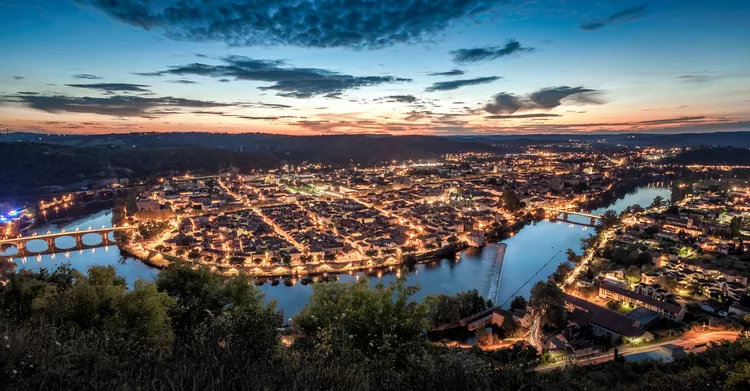Summary
Tucked into a rounded nook of the Lot River, Cahors is a lovely medieval city almost entirely surrounded by water. As the heart of wine country, the city’s most memorable landmark is the Valentré Bridge, along with the nearby ramparts and the cathedral.
The city’s main thoroughfare, Boulevard Léon Gambetta, is pleasant for a stroll, as is the medieval neighborhood just to the east of the road.
Cahors makes a great stop if you’re on a barge cruise through Gascony.
Cahors and a Deal With the Devil
It took seven decades in the 1300s to build Valentré Bridge. Legend has it that the builder made a pact with the devil to assist in the completion of the bridge. However, at the end of the work, he tried to renege on the agreement by refusing to place the last stone onto the bridge. In the 1800s, during a restoration of the bridge, a carving of a devil was added to the top of one of the three towers.
The bridge is dramatic with its three massive towers, which once had portcullises and gates to secure against the enemy.
Cahors History and Geography
Cahors experienced its heyday in the 13th century, when Lombard bankers and international tradespeople flocked to the town, transforming it into a center of Europe’s financial activities. Pope John XXII, a notable figure, was born here and established the now-defunct University of Cahors in the 1500s.
The city’s ramparts were fortified in the mid-1300s, coinciding with the construction of the famous Valentré Bridge.
Additionally, Cahors was one of the stops along the well-known pilgrim walking routes to St. James in Spain.
During the 19th century, many key structures were built in the city, including the town hall, theater, courts, and library. Consequently, Boulevard Gambetta evolved into a bustling street hosting the city’s twice-weekly market.
Interesting Cahors trivia: While you will find a Boulevard Gambetta in almost every French city, Cahors holds a special claim to the name as popular French leader Léon Gambetta (1838-1882) was born here. You can find a statue of Gambetta at Place François Mitterrand.
Getting to Cahors
The nearest major airports are in Toulouse and Rodez, both of which offer rail connections to Cahors. Alternatively, you can fly into Paris and take the train (five hours by day, seven hours overnight) to Cahors.
The French rail system connects various larger villages. However, a rental car is recommended for exploring this region. Even if you plan to stay in Cahors for your entire visit, you may want to rent a car for a day to visit nearby vineyards.
When visiting Cahors, it’s best to park in the city center and walk to most attractions, as they are within a compact area radiating from the main street.
Sightseeing in Cahors
- Top of the list is the city’s trademark image: the Valentré Bridge, located at the northwest corner of downtown.
- Shop for this region’s famous ‘black diamond’ in the local truffle markets. Limogne has a summer truffle market on Sundays at 10 am from mid-June to mid-August, while the winter truffle market operates from the first Friday in December through March (every Friday from 10:30 am). Lalbenque’s market features truffles on Tuesday afternoons from early December to March.
- Wine enthusiasts should not miss the chance to visit a local museum dedicated to wine and food from the region. La Chantrerie (35, rue de Chantrerie) showcases methods used in developing local wines and highlights the main dishes of Quercy: foie gras, truffles, Cahors wine, walnuts, fruits, and Quercy lamb.
- Saint-Etienne Cathedral (rue de Chantrerie) was consecrated in 1119 and is characteristic of the churches of this part of Périgord, featuring a central nave with no aisles, accented by two decorated domes that draw the eye upwards. Its most fascinating relic, known as the ‘holy cap’ or ‘cap of Christ’, was brought to Cahors by Bishop Géraud de Cardaillac from the Holy Land in the 12th century, believed to have covered Christ’s head in his tomb.
- Musée Henri Martin (located at 792, rue Emile Zola) displays works by its namesake painter and also features an exhibit dedicated to the city’s most famous son, Léon Gambetta. Note that the museum is currently closed for renovations.
Where to Stay in Cahors
- There is a small selection of hotels in Cahors. You can find guest reviews and prices on various travel platforms.
- If you want to experience one of France’s best château hotels, consider the Château de la Treyne, located about an hour away by car.
- Another great option is Le Vieux Logis, a charming old manor house where you can dine under the stars during the summer months.
More Sightseeing in the Lot Valley
- The Lot is renowned for its various mills (moulins). Some, like the 15th-century working watermill the Moulin de Seyrinac (located in Lunan), are open for tours. Additionally, you should try to visit the fortified water mill, the Moulin de Cougnaguet, located further away.
- One significant attraction in the Lot includes painted caves, offering a rare view of early human artwork. The Centre de Préhistoire de Pech Merle features remarkable paintings of horses, bison, and mammoths, alongside engravings dating back more than 20,000 years. Please note that visitor numbers are capped at 700 daily, so it is important to call ahead for reservations or book online, especially during peak summer season.
- The Grottes de Cougnac (located in Payrinac) also showcases exquisite drawings of deer, mammoths, human silhouettes, and geometric symbols, boasting the oldest figures still accessible to the public.
Edited by Mary Anne Evans





